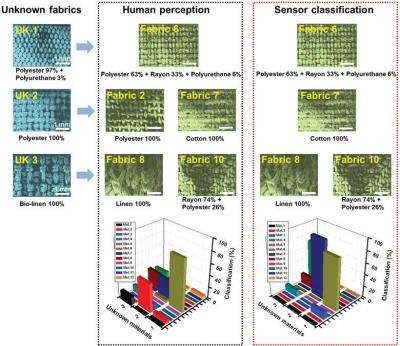Researchers at Hanyang University in South Korea have taken a significant step towards human-like touch sensing with a sensor made of a graphene-flake film supported on a robust polyethylene naphthalate substrate. They have combined an electric sensor with a machine-learning algorithm to create a device that can feel and distinguish different surface textures. The device could find use in virtual reality, robotics and medical prosthetics.

According to the team, machines can already recognize and replicate patterns associated with human speech and vision. Touch, however, is more complex to mimic because it relies on mechanoreceptors in the skin that sense tiny changes in pressure and vibrations when touching different surfaces.
The team explains that most tactile sensors detect a touching event by measuring the strength of a structural deformation. This means they are not true tactile sensors in principal because such sensors don’t sense the surface texture itself. In contrast, the Korean research team incorporated the graphene film onto an artificial fingerprint structure so the film reacts to tiny vibrations caused by the ridges on the fingerprint rubbing against a textured surface. Analyzing these vibration signals allows the sensor to feel differently textured fabrics.
Darren Lipomi from University of California San Diego in the US, who also works on tactile sensing, says ‘there are few examples of electronic skin that can achieve human-like sensitivity to surface textures.’ He applauds how the team from South Korea also incorporate a machine-learning algorithm so that their sensor can ‘classify textures the same way that we do automatically in our brains.’
The machine-learning algorithm collects the conductance and resistance information from the sensor and uses it to define specific features associated with different surface texture types. After learning the features of known fabrics, the sensor was able to extrapolate this knowledge and significantly outperform humans when classifying 12 new fabrics scoring 99% compared to 58% in a blind test of 50 people. The team deliberately chose fabrics to highlight the sensitivity of the sensor textile surfaces can be very delicate and humans are not always able to tell them apart.